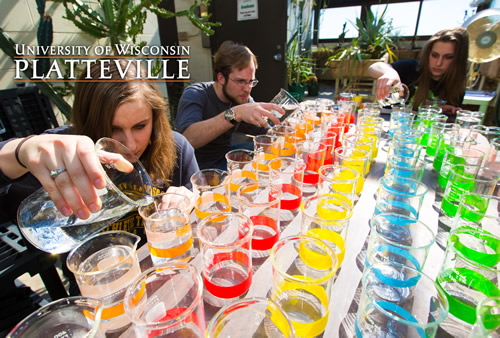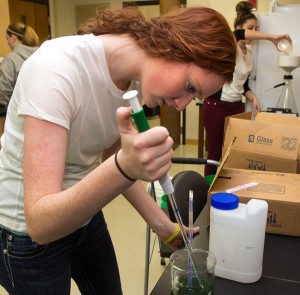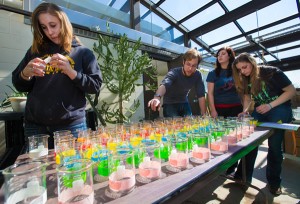PLATTEVILLE, Wis. — The University of Wisconsin-Platteville Pioneer Academic Center for Community Engagement (PACCE) program is funding a student research project to naturally clean algae infested ponds and lakes at both Gooseberry Hill and Lake Joy. Students participating in this research are in the Fundamentals of Biological Investigation class and Invertebrate Zoology class, taught by Dr. Becky Doyle-Morin.
The class will be working in cooperation with Gooseberry Hill to reduce its nuisance algae infestation. The students are working to find a clean, natural way to get rid of the toxic algae. The nuisance algae are cyanobacteria, or blue-green algae, which are capable of creating their own nitrogen and outcompeting the good algae in the pond.
“We need to find a way to clear the ponds naturally so that beneficial algae and other life within the pond will not be harmed,” said Doyle-Morin.
This past summer, students conducted similar studies at Lake Joy. “Students will compare Lake Joy to Gooseberry, and eventually other lakes as well,” said Doyle-Morin. “Having the opportunity to not only get hands-on experience that could expand our knowledge of biology but also helping the community, is a great way to understand how classroom learning is applied to real world situations,” said Kaitlyn Pleau, a biology major from Galena, Ill.
One method of controlling nuisance algal growth is the use of barley straw. The straw would be thrown onto the top of the lake and, as it breaks down, it would release a chemical that will inhibit the growth of the nuisance algae. Students used barley straw last year and found that it worked well but was not financially feasible for the larger ponds and lakes.
Barley straw is effective, in part, because of one of the byproducts, hydrogen peroxide. Doyle-Morin’s students have shown in the past that hydrogen peroxide is effective in isolation at controlling the nuisance algae. Students will continue to investigate the use of hydrogen peroxide, which ultimately breaks down into water and oxygen, as a natural cleaner.
Specifically, the invertebrate Zoology class will be looking at the effect of hydrogen peroxide on copepods, which are microscopic zooplankton, or free-swimming animals, found most lakes. The hydrogen peroxide may be good at clearing out nuisance algae, but students will be making sure that this method does not negatively impact the beneficial organisms in the lake.
Past classes have studied the effect of these natural algal controls on other zooplankton species and have found no negative impact. However, the copepods, which can eat the nuisance algae, did seem to be negatively affected in the past during the barley straw experiment. This year they will test if the hydrogen peroxide negatively impacts these copepods as well.
Another proposed natural method to reduce nuisance algae in ponds is the use of leaf litter, which may have the same decomposition effects as barley straw, but is already naturally found in proximity to most lakes. Students will compare the use of hydrogen peroxide to leaf litter in order to discern which method is more effective. Leaf litter is abundant and renewable, and the owners of Gooseberry Hill could harvest the leaf litter from their property every year.
Contact: Dr. Becky Doyle-Morin, biology, (608) 342-6156, doylemorinr@uwplatt.edu
Written by: Megan Schmidt, UW-Platteville University Information and Communications,
(608) 342-1194, schmidtme@uwplatt.edu

“ALGAE KNOWLEDGE:” The University of Wisconsin-Platteville Pioneer Academic Center for Community Engagement program is funding a student research project to naturally clean algae infested ponds and lakes at both Gooseberry Hill and Lake Joy. Students participating in this research are in the Fundamentals of Biological Investigation class and Invertebrate Zoology class, taught by Dr. Becky Doyle-Morin.


